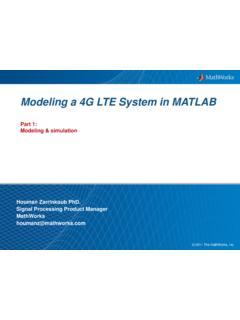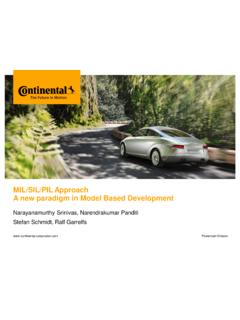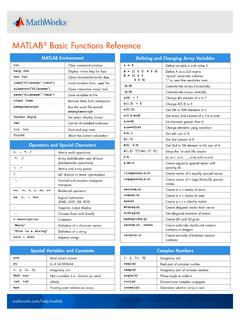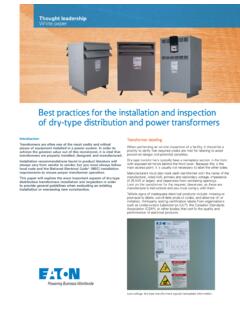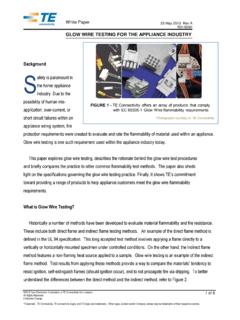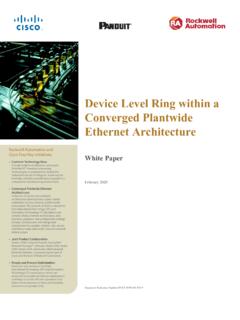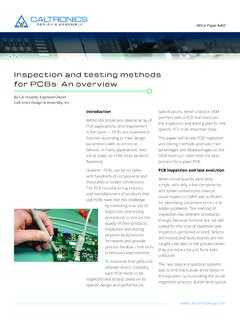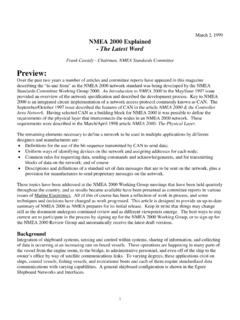Transcription of Developing Battery Management Systems with Simulink and ...
1 white paper . Developing Battery Management Systems with Simulink and Model-Based Design Developing Battery Management Systems with Simulink and Model-Based Design Across industries, the growing dependence on Battery pack energy storage has underscored the importance of bat- tery Management Systems (BMSs) that can ensure maximum performance, safe operation, and optimal lifespan under diverse charge-discharge and environmental conditions. To design a BMS that meet these objectives, engi- neers develop feedback and supervisory control algorithms that: Monitor cell voltage and temperature Estimate state-of-charge (SOC) and state-of-health (SOH).
2 Limit power input and output for thermal and overcharge protection Control the Battery charging profile Balance the state-of-charge of individual cells Isolate the Battery pack from source and load when necessary This paper describes how engineers develop BMS algorithms and software by performing system-level simulations with Simulink . Model-Based Design with Simulink enables you to gain insight into the dynamic behavior of the Battery pack, explore software architectures, test operational cases, and begin hardware testing early, reducing design errors. With Model-Based Design, the BMS model serves as the basis for all design and development activities, including desktop simulation of the design's functional aspects, formal verification and validation to industry stan- dards, and code generation for real-time simulation and hardware implementation (Figure 1).
3 DESKTOP SIMULATION REAL-TIME SIMULATION HARDWARE IMPLEMENTATION. Real-time Generate code RAPID PROTOTYPING. communication from model Algorithms running on a real-time computer HARDWARE. PROTOTYPING. Simulink MODEL. Generate code Battery packs, circuit, from model source, load Algorithms for cell balancing, SOC, SOH. Enviornment, source, Real-time Battery , circuit, load PRODUCTION CODE. communication Algorithms running HARDWARE-IN-THE-LOOP on an embedded TESTING microcontroller Behavioral models running on a Generate code real-time computer Real-time from model communication Figure 1. Battery Management system development workflow with Simulink and Model-Based Design.
4 W H I T E PA P E R | 2. Developing Battery Management Systems with Simulink and Model-Based Design Desktop Simulation. Desktop simulations in Simulink enable you to verify functional aspects of the BMS design, such as charge-discharge behavior (using single-cell equivalent circuit formulation), electronic circuit design, and feedback and supervisory control algorithms. On the desktop, the Battery system, environment, and algorithms are simulated using behavioral models. For example, you can explore active vs. passive cell balancing configurations and algorithms to evaluate the suitability of each balancing approach for a given application.
5 You can use desktop simu- lation to explore new design ideas and test multiple system architectures before committing to a hardware prototype. You can also perform requirements testing in desktop simulations, for example by verifying that contactors are pre- vented from opening or closing when an isolation fault is detected. Real-Time Simulation. Once validated via simulation, Simulink models can be used to generate C and HDL code for rapid prototyping (RP) or hardware-in-the-loop (HIL) testing to further validate the BMS algorithms in real time. With RP, instead of handwriting control software code for real-time testing, you generate code from your controller model and deploy it to a real-time computer that performs the functions of the production microcontroller.
6 With automatic code generation, algorithm changes made in the model can be tested on real-time hardware in hours rather than days. Further, you can interact with real-time control hardware from within Simulink to change algo- rithm parameters and log test data. As with rapid prototyping, HIL testing involves generating code from a Simulink model and deploying it to a real- time computer. In the case of HIL testing, code is generated from the Battery system models rather than the control algorithm models, providing a virtual real-time environment that represents Battery pack, active and passive circuit elements, loads, charger, and other system components.
7 This virtual environment lets you validate the functionality of the BMS controller in real time before Developing a hardware prototype and in an environment where hardware will not be damaged. Tests developed during desktop simulation can be carried over to HIL testing, to ensure that requirements are met as the BMS design progresses. Though HIL testing is employed primarily to test code running on a microcontroller or FPGA, you can instead use a rapid prototyping system, such as Simulink Real-Time and Speedgoat target hardware, connected to the HIL setup before production controller hardware is selected. Hardware Implementation. In the hardware implementation stage, the Simulink control models that have been ver- ified via desktop simulation, RP, and HIL are used to generate efficient, production-ready code for the BMS.
8 If neces- sary, production code generation can be incorporated into workflows compliant with formal certification standards used in the automotive, aerospace, and other regulated industries. Modeling and simulation with MATLAB, Simulink , and Simscape is faster, safer, and less costly than building physical prototypes. We can identify algorithms or charging methods that will work for a particular design without running the whole system. We can test sce- narios that would be difficult or hazardous to test on real batteries and optimize designs for specific applications and usage profiles.. Cecilia Wang, Romeo Power Read story W H I T E PA P E R | 3.
9 Developing Battery Management Systems with Simulink and Model-Based Design Desktop Simulation: Modeling BMS Software The ability to perform the realistic simulations that are central to the development of BMS control software starts with an accurate model of the Battery pack. Batteries are often designed using finite element analysis (FEA) models that account for the physical configuration of the batteries and capture their electro-thermochemical properties. Although these models are excellent for designing and optimizing a Battery pack's chemistry and geometry, control engineers need models that are better suited for system-level design and software development.
10 Many of our initial Battery models were empirical, with an ideal voltage source and a fixed impedance. We now use much more sophisticated first-principles models, and as a result, have gained invaluable insights into the Battery as an electrochemical device. We used Simulink to build advanced equivalent circuit models that can predict performance at different states of charge, discharge rates, temperatures, and levels of aging. We used a similar approach to perform safety-critical simulations to predict cooling per- formance within the Battery and ensure that the Battery packs would not overheat. To capture all the multidomain physical, chemical, and heat-transfer effects would typically require a finite-element analysis tool and significant effort.
